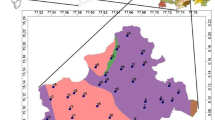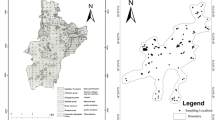Abstract
Incidence of high fluoride (F−) in groundwater (>1.5 mg/L) in two tribal belts of eastern India, one around Chukru in the Palamau district of Jharkhand and the other around Karlakot in the Nuapada district of Odisha, has been studied. The maximum concentration of F− in groundwater from dug wells and tube wells is 10.30 mg/L in Chukru and 4.62 mg/L in Karlakot. The groundwaters are mildly alkaline with pH ranges of 7.52–8.22 and 7.33–8.20 in Chukru and Karlakot, respectively. The F− concentration is positively correlated with pH, electrical conductivity and SO4 2− in both areas. The high F− in groundwater resulted mainly from dissolution of biotite and fluorapatite in quartzofeldspathic gneiss. The ionic dominance pattern (in meq/L) is mostly in the order Ca2+ > Na+ > Mg2+ > K+ among cations and HCO3 − > SO4 2− > < Cl− > F− among anions in the Karlakot groundwater. Preliminary adsorption experiments were conducted on natural haematite iron ore and synthetic magnetite to evaluate their potential for F− removal from water. Effects of different parameters such as contact time, pH, adsorbent dose and initial F− concentration on the adsorption capacity of these materials were investigated. Strong dependence of F− removal on pH was observed for both the adsorbents. With natural haematite iron ore, the maximum F− removal of 66 % occurred at an initial pH of 3.2 for a solution with F− concentration of 3 mg/L, adsorbent dose of 7 g/L and overnight contact time. The haematite iron ore was observed to increase the pH of the F− solution. Adsorption equilibrium was not achieved with this adsorbent even after a contact time of 45.2 h. In the case of synthetic magnetite, 84 % F− removal was achieved after 2 min of contact time for a solution with F− concentration of 6 mg/L, adsorbent dose of 10 g/L and initial pH of 7. The results indicate high potential of both natural haematite iron ore and synthetic magnetite as adsorbents of F− in water.








Similar content being viewed by others
References
Agarwal M, Rai K, Shrivastav R, Dass S (2002) A study of fluoride sorption by montmorillonite and kaolinite. Water Air Soil Pollut 141:247–261
APHA (1998) Standard methods for the examination of water and wastewater, 20th edn. American Public Health Association, Washington
Avishek K, Pathak G, Nathawat MS, Jha U, Kumari N (2010) Water quality assessment of Majhiaon block of Garwa district in Jharkhand with special focus on fluoride analysis. Environ Monit Assess 167:617–623
Avtar R, Kumar P, Surjan A, Gupta LN, Roychowdhury K (2013) Geochemical processes regulating groundwater chemistry with special reference to nitrate and fluoride enrichment in Chhatarpur area, Madhya Pradesh, India. Environ Earth Sci 70:1699–1708
Ball JW, Nordstrom DK (1991) User’s manual for WATEQ4F, with revised thermodynamic data base and test cases for calculation speciation of major, trace, and redox elements in natural waters. US Geological Survey Open-File Report 91–193, p 189
Barbier O, Arreola-Mendoza L, Del Razo LM (2010) Molecular mechanisms of fluoride toxicity. Chem Biol Interact 188:319–333
Bhatnagar A, Kumar E, Sillanpaa M (2011) Fluoride removal from water by adsorption–a review. Chem Eng J 171:811–840
Biswal TK, De Waele B, Ahuja H (2007) Timing and dynamics of the juxtaposition of the Eastern Ghats Mobile Belt against the Bhandara Craton, India: A structural and zircon U–Pb SHRIMP study of the fold-thrust belt and associated nepheline syenite plutons. Tectonics 26, TC4006. doi:10.1029/2006TC002005
Cerklewski FL (1997) Fluoride bioavailability: nutritional and clinical aspects. Nutr Res 17:907–929
Chae GT, Yun ST, Kwon MJ, Kim YS, Mayer B (2006) Batch dissolution of granite and biotite in water: implication for fluorine geochemistry in groundwater. Geochem J 40:95–102
Chairat C, Schott J, Oelkers EH, Lartigue JE, Harouiya N (2007) Kinetics and mechanism of natural fluorapatite dissolution at 25 C and pH from 3 to 12. Geochim Cosmochim Acta 71:5901–5912
Chatterjee N, Ghose NC (2011) Extensive early Neoproterozoic high-grade metamorphism in North Chotanagpur Gneissic Complex of the Central Indian Tectonic Zone. Gondwana Res 29:279–363
Chidambaram S, Prasad MBK, Manivannan R, Karmegam U, Singaraja C, Anandhan P, Prasanna MV, Manikandan S (2013) Environmental hydrogeochemistry and genesis of fluoride in groundwaters of Dindigul district, Tamilnadu (India). Environ Earth Sci 68:333–342
Das S, Mehta BC, Samanta SK, Das PK, Srivastava SK (2000) Fluoride hazards in ground water of Orissa, India. J Environ Health 42:40–46
Gitari WM, Ngulube T, Masindi V, Gumbo JR (2013) Defluoridation of groundwater using Fe3+-modified bantonite clay: optimization of adsorption conditions. Desal Water Treat. doi:10.1080/19443994.2013.855669
Guidry MW, Mackenzie FT (2003) Experimental study of igneous and sedimentary apatite dissolution: control of pH, distances from equilibrium, and temperature on dissolution rates. Geochim Cosmochim Acta 67:2949–2963
Jagtap S, Yenkie MK, Labhsetwar N, Rayalu S (2012) Fluoride in drinking water and defluoridation of water. Chem Rev 112:2454–2466
Kantharaja DC, Lakkundi TK, Basavanna M, Manjappa S (2012) Spatial analysis of fluoride concentration in groundwaters of Shivani watershed area, Karnataka state, South India, through geospatial information system. Environ Earth Sci 65:67–76
Kularatne KUKS, Pitawala HMTGA (2012) Leaching of fluoride from biotite mica in soil: implications for fluoride in shallow groundwater. Int Sch Res Netw Soil Sci 2:7. doi:10.5402/2012/739051
Kundu N, Panigrahi MK, Tripathy S, Munshi S, Powell M, Hart BR (2001) Geochemical appraisal of fluoride contamination of groundwater in the Nayagarh district, Orissa, India. Environ Geol 41:451–460
Loganathan P, Vigneswaran S, Kandasamy J, Naidu R (2013) Defluoridation of drinking water using adsorption processes. J Hazard Mater 248–249:1–19
Mamatha P, Rao SM (2010) Geochemistry of fluoride rich groundwater in Kolar and Tumkur districts of Karnataka. Environ Earth Sci 61:131–142
Meenakshi, Maheshwari RC (2006) Fluoride in drinking water and its removal. J Hazard Mater B137:456–463
Mohapatra M, Anand S, Mishra BK, Giles DE, Singh P (2009) Review of fluoride removal from drinking water. J Environ Manag 91:67–77
Mohapatra M, Hariprasad D, Mohapatra L, Anand S, Mishra BK (2012) Mg-doped nanoferrihydrite–a new adsorbent for fluoride removal from aqueous solutions. Appl Surf Sci 258:4228–4236
Nordstrom DK, Jenne EA (1977) Fluoride solubility in selected geothermal waters. Geochim Cosmochim Acta 41:175–188
Nordstrom DK, Ball JW, Donahoe RJ, Whittemore D (1989) Groundwater chemistry and water-rock interactions at Stripa. Geochim Cosmochim Acta 53:1727–1740
Padhi S, Muralidharan D (2012) Fluoride occurrence and mobilization in geo-environment of semi-arid Granite watershed in southern peninsular India. Environ Earth Sci 66:417–479
Pattnaik M, Mishra S (2002) Effect of fluoride in groundwater around Karlakot village of Nuapada district, Orissa: a geoenvironmental assessment. Soc Geosci Allied Technol Bull 2:32–35
Rahmani AN, Nouri J, Ghadiri SK, Mahvi AH, Zare MR (2010) Adsorption of fluoride from water by Al3+ and Fe3+ pretreated natural Iranian zeolites. Int J Environ Res 4:607–614
Rao NS, Subrahmanyam A, Rao GB (2013) Fluoride-bearing groundwater in Gummanampadu Sub-basin, Guntur district, Andhra Pradesh, India. Environ Earth Sci 70:575–586
Saxena VK, Ahmed S (2001) Dissolution of fluoride in groundwater: a water–rock interaction study. Environ Geol 40:1084–1087
Saxena VK, Ahmed S (2003) Inferring the chemical parameters for the dissolution of fluoride in groundwater. Environ Geol 43:731–736
Shyam R, Kalwannia GS (2012) Health risk assessment of fluoride with other parameters in groundwater of Sikar city (India). Environ Earth Sci 65:1275–1282
Sikdar PK, Adhikari SK, Bhattacharya BB (2007) Lineament density modelling to identify high potential aquifers in hard rock areas. J Geol Soc India 69:1118–1131
Simard RR, Lafrance P (1996) Fluoride sorption and desorption indices in Quebec soils. Commun Soil Sci Plant Anal 2:853–866
Srivastava SK, Tiwari SK (2006) Distribution of high fluoride in ground water of Orissa. Soc Geosci Allied Technol Bull 7:18–26
Susheela AK (2007) A Treatise on Fluorosis. Fluorosis Research and Rural Development Foundation, New Delhi, 133 p
UNICEF (1999) States of the art report on the extent of fluoride in drinking water and the resulting endemicity in India. Report by Fluorosis and Rural Development Foundation for UNICEF, New Delhi
Vikas C, Kushwaha R, Ahmad W, Prasannakumar V, Reghunath R (2013) Genesis and geochemistry of high fluoride bearing groundwater from a semi-arid terrain of NW India. Environ Earth Sci 68:289–305
WHO (1997) Guideline for drinking water quality health criteria and other supporting information, 2nd edn. World Health Organisation, Geneva
Acknowledgments
Mr. Prabir K. Naik of the Central Ground Water Board, Bhubaneshwar is thanked for help during field work in the Karlakot area. Grants under FIST and IRPHA programmes of the Department of Science and Technology, Govt. of India for establishing the ICP–AES and EPMA facilities, respectively, at IIT Bombay are gratefully acknowledged. Dr. Mugera Gitari is thanked for valuable suggestions for improving the quality of the manuscript.
Author information
Authors and Affiliations
Corresponding author
Rights and permissions
About this article
Cite this article
Patel, S.C., Khalkho, R., Patel, S.K. et al. Fluoride contamination of groundwater in parts of eastern India and a preliminary experimental study of fluoride adsorption by natural haematite iron ore and synthetic magnetite. Environ Earth Sci 72, 2033–2049 (2014). https://doi.org/10.1007/s12665-014-3112-1
Received:
Accepted:
Published:
Issue Date:
DOI: https://doi.org/10.1007/s12665-014-3112-1




